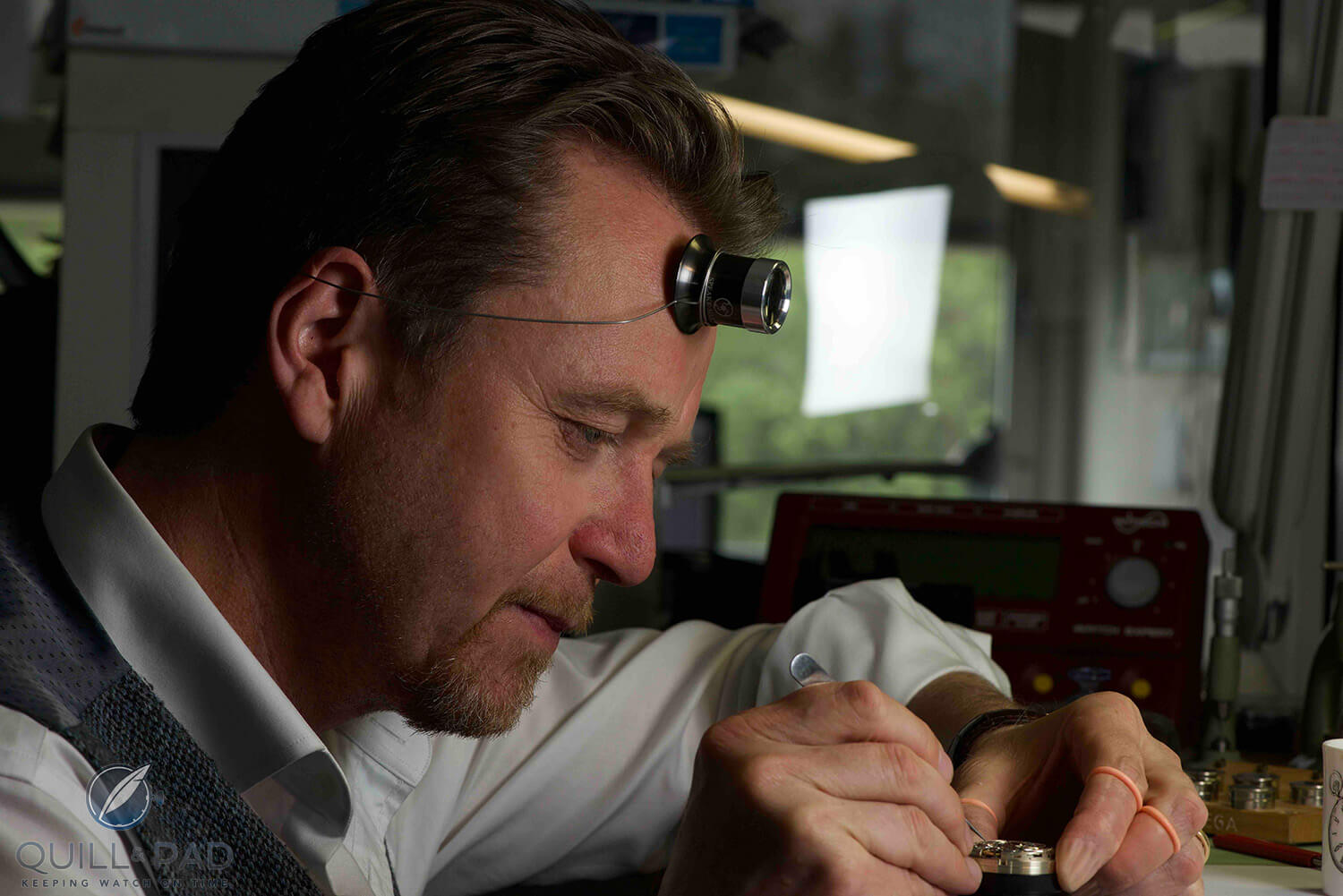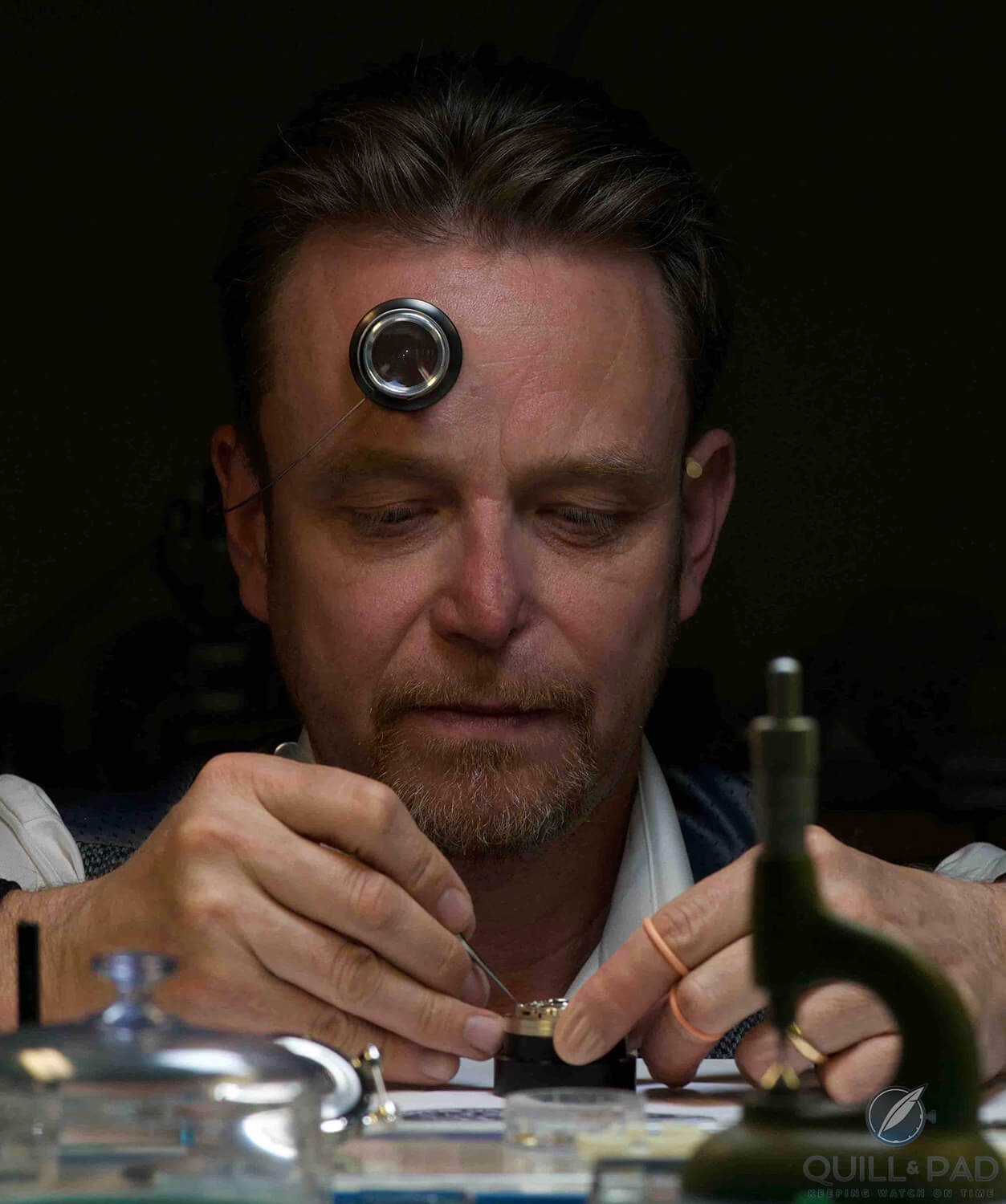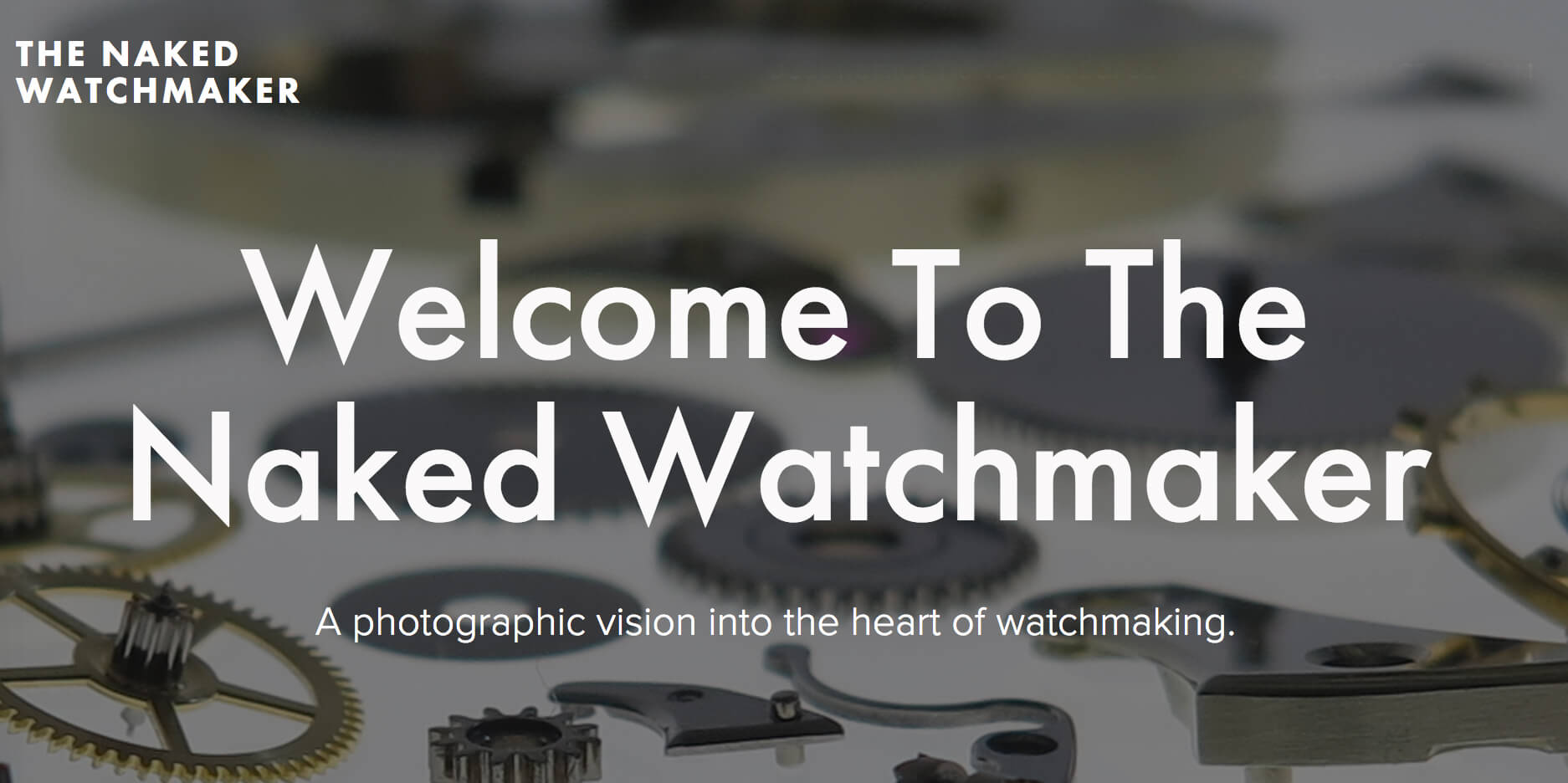In 1985 I walked into Hackney Technical College; the course on horology had already started two weeks earlier, but I was welcomed on board and so began my education in horology.
My journey continued from Hackney Technical College to WOSTEP in Neuchâtel, and then back to the United Kingdom for my first commercial position in Oxford, predominantly working on Rolex.
Six months later on New Bond Street I became the Piaget watchmaker, and six months after that I entered Omega in Southampton. My education was moving fast, but it was about to take an entirely new direction.
In 1990, I entered Somlo Antiques in the Piccadilly arcade and found my home for the next six years. It was to become a watchmaker’s Mecca: as Somlo did not have a workshop, my mandate was to build one while restoring and servicing watches dating back to the dawn of watchmaking. Every collectible brand – known and forgotten – crossed my bench.

Peter Speake-Marin at the bench
Here I fell in love with watchmaking, from antique verge pocket watches to 1950s Patek Philippe perpetual calendars. Even Ingersoll Mickey Mouse watches landed on my bench!
With limited equipment but a youthful attitude dictating that anything was possible, we restored everything that entered the workshop without hesitation or doubt.
The learning curve was steep and I thrived and grew, loving the surprise of each next timepiece as it appeared. The worse the condition, the bigger the restoration, the better the challenge.
In the basement we had a medium-format Mamiya camera with Polaroid back, which was permanently set up on a vertical stand to record the watches that came through the boutique. After a few years I began using the Mamiya to take pictures of pieces I restored and write accompanying articles, which were published in The Horological Journal and the British edition of International Watch (defunct, it has now morphed into QP).
Each article, which became a monumental amount of work for somebody who was neither a photographer nor a writer, was compensated with about £100; this was purely a labor of love. I enjoyed sharing what I had grown to love with other people, and through the boutique I discovered there were quite a few of us bitten by this obscure fascination for watchmaking.
However, unlike them, I was inside horology and not just looking in from the outside.
Leaving London
I left London in 1996 and moved to Switzerland. After six years in a mixed horological heaven the learning curve had tapered and an early desire to leave the UK had reared its head.
Following a wine festival in Neuchâtel that often saw me returning after my time at WOSTEP, I met an old friend working at Renaud et Papi, a company making complicated wristwatch movements. The following week I received a proposal to work there, and a few months later I was on my way.
In 1997 I finished my last published article, one that I had begun in London about an early Patek Philippe perpetual calendar made for the Russian market. A fellow watchmaker at Renaud et Papi, Marco Mäkinen, made a sketch that helped me explain the mechanism.
What drove me to write these articles was in part a desire to share what I had learned with anyone who was interested, but in this particular watch – an obscure Patek Philippe pocket watch from 1890 – something else came to light, which is really why I had taken the time to document and deconstruct it.
As I removed its bezel, I had the sense that it had not been opened since it was first closed. Or, if it had, half a century or more had lapsed since then.
The enamel dial was held in place by a skirt circling it that is pushed onto the main plate. To remove it, you gently lever it off at multiple points around the dial until it simply works free. As I did this (as I had on many pieces before), there was an audible click – nothing breaking, but the sense that a seal that had developed between the metal skirt and the German silver main plate was being broken.
When the dial lifted off I had the image of an Egyptian tomb being opened many millennia after it had been closed and air rushing in for the first time since it had been sealed.
I was able to view the perpetual calendar mechanism, which was in theory no different to many others I had worked on and the same in principle to those that are often made today.
An abridged first paragraph of my article 20 years ago reads as follows, “The Patek Philippe pocket watch shown in these pictures was made in 1890 and sold on January 14, 1901 to a Russian from Kharvoc, a town in the north of the Ukraine. His name, translated into English, was Vasiliy Trofimovich . . . The watch was sold in the same year Marconi was testing radio transmissions from England to Newfoundland; only five years before the watch was made, Gottlieb Daimler had produced the first motor bike . . . the same principles used in this watch are still being used today.”
I photographed and recorded this watch because I wanted to share with others what generally myself and only a few other watchmakers ever saw. No CAD program existed to design the mechanism, and no CNC machining to simplify the machining process.
The finishing on everything I viewed, as with the design and all parts of the execution, would have been made by men and woman who have long left this world and moved on to the next. But their work was in front of me, and I wanted to show it to others so they could appreciate it too; I wanted to show the time spent making this watch and its components, which had been hidden for a century.
I ended the article by writing: “ . . . it was another six years before the Wright Brothers even showed an interest in aviation and 13 years before the first self-propelled aircraft took off . . .”

Peter Speake-Marin. The Naked Watchmaker
And now?
Mechanical watchmaking is no longer about necessity, we don’t need mechanical instruments for telling time; those days are long past us. Watchmaking, however, remains an affluent billion-Swiss franc business even during periods of challenge.
Horology in its purist form is not even about telling time, it is about the people and the time spent by them to make a wonderful object that rests on an individual’s wrist.
These stories make us what we are: human. And this is why I wrote that article in 1997.
Twenty years have passed almost to the day since I wrote about this pocket watch, and today I have started again to deconstruct watches in multiple categories under a new guise. During those 20 years my education has gone beyond anything I had ever imagined it would travel to – as has the technology surrounding us.
My aspiration today is that The Naked Watchmaker will in the fullness of time become a point of reference where people can understand more about horology – both modern and old – on a level that has never before existed.
My Mamiya has been replaced by a modern digital camera; my prehistoric Compaq by a Mac; and paper magazines by a website and social media. The reason for the deconstructions remains the same but the tools have transitioned to another universe.
My goal is to share a passion for watchmaking; to put on display the creativity of individuals, some who left many years ago and others who are still here today – individuals taking ideas from their minds and turning them into objects that prove that whatever is in our imagination can be made into something real and sometimes something quite extraordinary.
For more information, please visit www.thenakedwatchmaker.com.
Leave a Reply
Want to join the discussion?Feel free to contribute!






















































Looking forward to
Discussions on watchmaking and concepts/ Philosophies
Satire , life that branch out from horological discussion